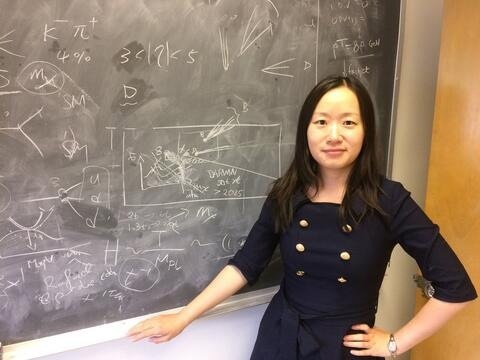Reviewed by Mila PereraSep 9 2022
The cosmos was populated with equal numbers of matter and “antimatter” — particles that are matter counterparts but have opposite charges — right after the Big Bang. The universe then cooled as space expanded.
 Yanou Cui. Image Credit: (UCR/I. Pittalwala).
Yanou Cui. Image Credit: (UCR/I. Pittalwala).
Today’s universe is filled with matter-based galaxies and stars, but researchers are still perplexed by its cosmic genesis, questions of how matter came to rule the universe, and where antimatter went.
By using the “cosmological collider,” researchers at the University of California, Riverside, and Tsinghua University in China have created a new method for studying the cosmic origin of matter.
Not Just Any Collider
High-energy colliders, like the Large Hadron Collider, have been designed to generate extremely heavy subatomic elementary particles that could reveal new physics.
However, certain novel physics, like those describing dark matter and the genesis of matter, can entail far heavier particles, necessitating more energy than a human-made collider can deliver. It turns out that the early universe could have functioned as a super-collider.
Yanou Cui, an associate professor of physics and astronomy at UCR, stated that cosmic inflation, a period when the universe grew at an exponentially accelerating pace, is commonly thought to have preceded the Big Bang.
Cosmic inflation provided a highly energetic environment, enabling the production of heavy new particles as well as their interactions. The inflationary universe behaved just like a cosmological collider, except that the energy was up to 10 billion times larger than any human-made collider.
Yanou Cui, Associate Professor, Physics and Astronomy, University of California, Riverside
As per Cui, when the cosmos expanded, microscopic structures formed by intense events during inflation were stretched, leading to zones of varied density in an otherwise homogenous universe. These microscopic patterns then seeded the large-scale structure of our universe, which is seen today as the spread of galaxies throughout the sky.
Cui noted that analyzing the imprint of the cosmological collider in today’s cosmos’ contents, like galaxies and the cosmic microwave environment, may disclose novel subatomic particle physics.
Cui and Zhong-Zhi Xianyu, assistant professors of physics at Tsinghua University, reported that the secret of the cosmic origin of matter might be solved by implementing the physics of the cosmological collider and using precision data for assessing the structure of our universe from experimental studies like SPHEREx and 21-cm line tomography.
The study was published in the journal Physical Review Letters.
“The fact that our current-day universe is dominated by matter remains among the most perplexing, longstanding mysteries in modern physics. A subtle imbalance or asymmetry between matter and antimatter in the early universe is required to achieve today’s matter dominance but cannot be realized within the known framework of fundamental physics,” Cui said.
Leptogenesis to the Rescue
Cui and Xianyu suggest testing leptogenesis, a well-known process that underlies the origin of baryon asymmetry in our universe (visible gas and stars). If the cosmos had started with equal quantities of matter and antimatter, they would have destroyed one another into photon radiation, leaving nothing behind. Asymmetry is essential for explaining the discrepancy because matter significantly outnumbers antimatter now.
Leptogenesis is among the most compelling mechanisms generating the matter-antimatter asymmetry. It involves a new fundamental particle, the right-handed neutrino. It was long thought, however, that testing leptogenesis is next to impossible because the mass of the right-handed neutrino is typically many orders of magnitudes beyond the reach of the highest energy collider ever built, the Large Hadron Collider.
Yanou Cui, Associate Professor, Physics and Astronomy, University of California, Riverside
The current study offers to evaluate leptogenesis by decoding the precise statistical features of the distribution pattern of objects in the observed cosmic structure, which is similar to the microscopic physics during cosmic inflation.
According to scientists, the cosmological collider effect facilitates the synthesis of the super-heavy right-handed neutrino during the inflationary epoch.
“Specifically, we demonstrate that essential conditions for the asymmetry generation, including the interactions and masses of the right-handed neutrino, which is the key player here, can leave distinctive fingerprints in the statistics of the spatial distribution of galaxies or cosmic microwave background and can be precisely measured,” Cui said.
“The astrophysical observations anticipated in the coming years can potentially detect such signals and unravel the cosmic origin of matter.”
Cui’s study was funded by a grant from the United States Energy Department.
Journal Reference:
Cui, Y & Xianyu, Z-Z. (2022) Probing Leptogenesis with the Cosmological Collider. Physical Review Letters. doi.org/10.1103/PhysRevLett.129.111301.